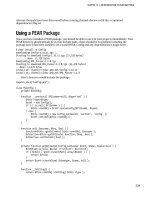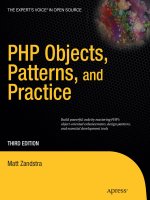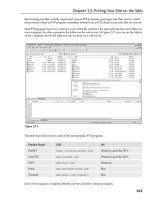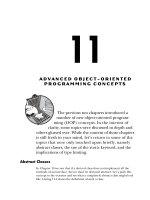OBJECT-ORIENTED PHP Concepts, Techniques, and Code- P12 pptx
Bạn đang xem bản rút gọn của tài liệu. Xem và tải ngay bản đầy đủ của tài liệu tại đây (428.12 KB, 10 trang )
11
ADVANCED OBJECT-ORIENTED
PROGRAMMING CONCEPTS
The previous two chapters introduced a
number of new object-oriented program-
ming (OOP) concepts. In the interest of
clarity, some topics were discussed in depth and
others glossed over. While the content of those chapters
is still fresh in your mind, let’s return to some of the
topics that were only touched upon briefly, namely
abstract classes, the use of the
static keyword, and the
implications of type hinting.
Abstract Classes
In Chapter 10 we saw that if a derived class does not implement all the
methods of an interface, then it must be declared
abstract. Let’s push this
concept to the extreme and see what a completely abstract class might look
like. Listing 11-1 shows the definition of such a class.
OOPHP_02.book Page 91 Friday, May 5, 2006 2:25 PM
92 Chapter 11
abstract class Bird{
protected $plumage;
protected $migratory;
abstract public function __construct();
abstract public function fly();
abstract public function sing();
abstract public function eat();
abstract public function setPlumage($plumage);
abstract public function getPlumage();
abstract public function setMigratory($migratory);
abstract public function getMigratory();
}
Listing 11-1: The definition of the abstract class
Bird
As we saw in Chapter 10, any class that contains abstract methods must
include
the keyword abstract in its class declaration. That class may have
any number of data members and any number of methods with or without
an implementation. However, if a method lacks an implementation it must
also be declared
abstract.
The class in Listing 11-1 has data members declared as
protected, making
them available to derived classes. This class could be termed a pure abstract
class because all of its methods are abstract. Note that all the methods of
this class are declared
public. Let’s see why that is so.
Private Methods Can’t Be Abstract
Methods identified as abstract cannot be private; they must be either public
or protected. The reason is that an abstract private method is a contradic-
tion in terms. Because an abstract class has undefined methods it cannot be
instantiated (it only exists to be the parent of a derived class). A class with
abstract private methods could never be implemented because private meth-
ods cannot be inherited. The same reasoning would apply to a final abstract
method.
NOTE Recall that a final method cannot be changed in a derived class. An abstract method
cannot be final because it must be overridden—i.e., changed.
How does a pure abstract class, with no defined methods, differ from an
interface? An interface may not have data members or a constructor. (This
may change in future versions of PHP. There is some discussion of allowing
interfaces to have constructors.) In order to turn the
Bird class, shown in
Listing 11-1, into an interface you would have to replace the keywords
abstract class with interface and remove $plumage, $migratory, and the
constructor. Although interface methods are effectively abstract, you still
need to remove the
abstract descriptor for each method.
Interface or Pure Abstract Class?
You now know the syntactic differences between interfaces and pure abstract
classes, but when should you use one rather than the other? In general, it’s
probably better to use an interface than a pure abstract class because of the
OOPHP_02.book Page 92 Friday, May 5, 2006 2:25 PM
Advanced Object-Oriented Programming Concepts 93
flexibility of interfaces. PHP doesn’t allow multiple inheritance for classes;
a child class may have only one parent class. However, you can implement
any number of interfaces.
It makes more sense to use abstract classes when there is a mix of concrete
and abstract methods. You can provide an implementation where identical,
derived class behavior is expected, and you can provide an abstract method
where behavior will differ. You could, of course, ignore methods for which
you expect the behavior of derived classes to diverge, but by declaring a
method abstract you ensure that it will be implemented in any derived
class. You’ll see how this can be used to your advantage in the following
discussion of polymorphism.
Polymorphism
In Chapter 10 you created a MySQLException class by inheriting from Exception.
Type hinting allowed you to easily distinguish different kinds of exceptions
and made it possible to have more than one
catch block. However, when
using type hinting, you also had to order the
catch blocks carefully to make
sure that the child preceded the parent. Specifically,
MySQLException had to
precede
Exception because a catch block that catches the Exception class will
also catch any derived class. Because it is derived from
Exception, MySQLException
can be caught by an
Exception catch block. A parent class can stand in for its
children, but a child cannot stand in for its parent. (This may look like a draw-
back, but you’ll soon see how it can be used to advantage.)
Controlling How Functions Are Used
Type hinting can give a programmer more control over the way that a func-
tion is used. Suppose you derive a
Canary class and a Lark class from the Bird
class shown in Listing 11-1. You could pass either a canary or a lark to the
function in Listing 11-2.
function doSomething(Bird $b){
//do something
$b->sing();
//do something else
}
Listing 11-2: A function that uses type hinting to specify a
Bird object
Even though the Bird class is an abstract class that cannot be instantiated,
you can use it to type hint the argument to this function in exactly the same
way that
catch blocks are type hinted.
In Listing 11-2, type hinting prohibits passing anything but a bird to the
function—passing any other object or a primitive will result in an error. In
this way, a programmer can restrict the way that a function is used. With
properly ordered
catch blocks you used type hinting to catch specific kinds of
exceptions. The
doSomething function does the converse; it catches any kind of
Bird. The ability to pass any kind of Bird to this function without knowing the
OOPHP_02.book Page 93 Friday, May 5, 2006 2:25 PM
94 Chapter 11
specific kind beforehand, with the expectation that it will behave as it is
supposed to behave, is known as polymorphism. The parent takes on the
characteristics of the child.
As you are aware, PHP is a weakly-typed language. In the strictest sense,
polymorphism requires a strongly-typed language such as Java or C++. In
these languages, whenever a variable is declared or used as a function
parameter, it is declared as a specific data type. In PHP, type hinting a
parameter doesn’t define the data type but merely filters for acceptable
types. In terms of the code in Listing 11-2,
Bird doesn’t define the type of $b;
it simply blocks out all other types. If this is the case, then
$b is a variable like
any other PHP variable, of no specific type. It is a variant that becomes a type
through assignment. You don’t in fact have a
Bird class with the capability
of performing the methods of whatever child class is passed. You have only
the child class itself. Hence it is disputable whether PHP in fact supports
polymorphism.
Regardless of whether PHP is truly polymorphic, the combination of
type hinting and abstract methods is a powerful tool. The former guaran-
tees a certain kind of object, and the latter guarantees the implementation
of particular methods. For these reasons you can be sure that any object
passed to the
doSomething function will implement the sing method. The
declaration of an abstract
sing method ensures that you can’t have a bird
that doesn’t sing and the type hint ensures that only a bird may be passed
to this function.
NOTE Type hinting is optional in all situations except catch blocks. A variable’s data type in
a
catch must be specified, and it must be an Exception or a class derived from Exception.
Type hinting applies to objects only (although as of PHP 5.1, arrays can also be type
hinted). Type-hinted code is also self-documenting because it makes the programmer’s
intentions explicit. (We’ll discuss this topic in greater detail in Chapter 14.)
Static Classes
In Chapter 9, you used a static data member to allow only one instance
of the MySQL database class. Whenever an attempt was made to create
an instance of this class, you were able to test the value of the
$instances
variable to ensure that no other instances existed. This test works because
a variable declared as
static is available to all instances of a class (or in this
case, would-be instances).
Static Math Classes
The ability to create classes that are entirely static allows us to encapsulate a
set of related unchanging data members and methods. Mathematics is an
ideal candidate for this kind of class because constants, such as pi and the
way of calculating the absolute value of a number, do not change. Listing 11-3
shows what a piece of the static
Math class might look like.
OOPHP_02.book Page 94 Friday, May 5, 2006 2:25 PM
Advanced Object-Oriented Programming Concepts 95
final class Math{
const PI = M_PI;
static public function abs($num){
return abs($num);
}
static public function sqrt($num){
return sqrt($num);
}
}
echo Math::PI;
echo '<br />';
echo Math::abs(-4.15);
echo '<br />';
echo Math::sqrt(9);
Listing 11-3: A portion of the code for a static
Math class
So far you have only seen the keyword final applied to methods. When
used as a class modifier, it defines a class that cannot be the parent of any
other class. A well-defined
Math class should have no need of subclasses—it
should not need to be extended and none of its methods overridden. The
keyword
final ensures this.
The
Math class contains mathematical constants and performs mathe-
matical functions. The constant data member
PI can be displayed by using
the class name and the scope resolution operator. Static methods are called
in a similar fashion. The use of the class name and the scope resolution
operator rather than the arrow operator indicates that the properties or
methods belong to the class as a whole and not to any specific instance.
Therefore, it is illegal to reference the pseudo-variable
$this from within a
static method because
$this refers to the current instance. A static method,
by definition, is not tied to any specific instance.
NOTE Unlike some other OO languages, PHP does not allow the keyword static to be applied
to a class as a whole. For example, attempting to declare
final static class Math will
result in an error. Therefore, when I speak of a static class in PHP, I am using the
term loosely. I really mean a class that has only static methods.
Instances of Static Classes
Because the keyword static cannot be applied to a class, you can create an
instance of a class even if that class has only static data members. For exam-
ple, you can create an instance of the
Math class from Listing 11-3:
$m = new Math();
echo $m->sqrt(9);
Although this coding style is not recommended, an instance of the Math
class will be created, and no error or notice will occur when you call the static
method
sqrt against this instance.
OOPHP_02.book Page 95 Friday, May 5, 2006 2:25 PM
96 Chapter 11
NOTE This will offend OO purists, because static methods belong to the class as a whole and
should not be called against instances. However, changes are afoot for PHP when it
comes to calling dynamic methods statically—“We will make calling a dynamic function
with the static call syntax
E_FATAL.”
1
Preventing Instantiation of a Static Class
It is quite easy to prevent your Math class from being instantiated. Simply add
a constructor like the following:
public function __construct(){
throw new Exception("Static class - instances not allowed.");
}
This constructor will throw an exception if there is an attempt to create
an instance of the
Math class.
We could go on to create a complete
Math class by adding all the appro-
priate methods, mostly wrapper methods for existing PHP functions, as we
did for the absolute value function and the square root function shown in
Listing 11-3. All in all, we can create a reasonable facsimile of a static class.
It makes sense to create a static
Math class for an entirely OO language
such as Java (after all, there’s no procedural way, in this case, of calling
mathematical functions), but the need to create static classes in a hybrid
language such as PHP is questionable. In this case the static methods of a
static
Math class provide the equivalent of global functions that already exist in
the PHP function library.
Although the value of static classes may be moot, you’ll see shortly that
static methods can be very useful.
Design Patterns
Originally, design patterns were templates used for solving common archi-
tectural problems, but they have also been applied to computer programming.
Patterns are somewhat akin to abstract classes or interfaces, but are even less
specific, providing only a general description of a solution.
The Singleton Pattern
One well-known and well-documented design pattern is the singleton pattern,
a pattern that ideally suits the database class you created in Chapters 9 and 10.
As the name implies, this pattern is used where only one instance of a class is
wanted.
Your implementation of the
MySQLConnect class uses a static variable
and throws an exception if there is an attempt to construct more than one
instance of the class. A more conventional implementation of the singleton
pattern might use a private constructor and a static method to return a class
1
PHP Developers Meeting, minutes (Paris, November 11–12, 2005), available at www.php.net/
~derick/meeting-notes.html. (Accessed April 4, 2006.)
OOPHP_02.book Page 96 Friday, May 5, 2006 2:25 PM
Advanced Object-Oriented Programming Concepts 97
instance. Let’s revise the MySQLConnect class to highlight the usefulness of static
methods. (I’ll outline only the major changes here; download the code if you
want to see them all.)
To begin with, the static data member designed to keep track of the
number of instances becomes a static data member for holding a reference
to the class instance.
private static $instance = NULL;
The constructor still creates a connection, but the access modifier
is changed from public to private and the test for existing instances is
removed.
private function __construct($hostname, $username, $password){
if(!$this->connection = mysql_connect($hostname, $username, $password)){
throw new MySQLException(mysql_error(), mysql_errno());
}
}
Because the constructor has been declared as private, you can only invoke
it from within the class. This may seem like an impossibility (how do you get
inside a class that you can’t create?), but a static method provides the means,
as shown in Listing 11-4.
static public function getInstance($hostname, $username, $password){
//instance must be static in order to be referenced here
if(self
::$instance == NULL ){
self::$instance = new MySQLConnect
($hostname, $username, $password);
return self::$instance;
}else{
$msg = "Close the existing instance of the ".
"MySQLConnect class.";
throw new MySQLException($msg, self::ONLY_ONE_INSTANCE_ALLOWED);
}
}
Listing 11-4: Static method for returning an instance
In order to reference the instance handle inside a static method, the
handle itself must be static. If no instance exists, the constructor
is called
and the returned object is copied into the static class variable
$instance.
The
getInstance method then returns a reference to this static data member.
Now, instead of directly creating an instance of the
MySQLConnect class by
calling the constructor, you invoke the static
getInstance method to perform
that task for you.
$instance = MySQLConnect::getInstance('localhost', 'user', 'password');
OOPHP_02.book Page 97 Friday, May 5, 2006 2:25 PM
98 Chapter 11
It was noted earlier that static methods can only reference static data
members. Conversely, static methods are prohibited from referencing regular
data members. This makes sense when you remember that regular data mem-
bers belong to and are created when objects are instantiated. By definition a
static method does not require an object, so those non-static data members
don’t exist. Likewise, as you saw earlier, a static method cannot use the pseudo-
variable
$this, since $this refers to the current instance.
NOTE A singleton class should also disallow clones. You’ll see how this is done in Chapter 13.
Which Implementation?
This revised MySQLConnect class has exactly the same functionality as the ori-
ginal. Apart from the way an instance is created, there is no other change
to the interface of the
MySQLConnect class. However, having a copy of the lone
instance stored in a static class variable allows you to return that instance
instead of throwing an exception, should an attempt be made to create a
second instance. This is exactly what some implementations of a singleton
database class do, but it is not always the desired behavior. What if the user
wants to connect to a different server? For this reason, in the section “Making
Other Connections” on page 68, we chose to force the user to close the
current connection before creating a new one.
The coding style of the original implementation may be more direct and
more readily understood, but having a reference to the class instance could
prove useful in some circumstances. If the
getInstance method receives a
request to connect to the same host with the same username, why not return
the current instance rather than throwing an exception?
Which version is preferable? It’s up to you to decide.
Where to Go from Here
The keywords abstract and static and the ability to type hint add powerful
capabilities that didn’t exist prior to PHP 5. Creating abstract methods
enforces specific kinds of behavior, and static methods and data members
make the implementation of a singleton pattern both easy and effective.
Type hinting makes the developer’s intentions clear and programmatically
enforces them.
These capabilities are not just syntactic icing on top of a procedural
language; they are a robust implementation of a fully OO language. PHP
may be unable to create a true static class, and whether it is truly polymorphic
is debatable, but the issue for PHP is always functionality rather than language
purity. There is no doubt that it does not suffer in this respect.
To this point we have created our own classes from scratch or inherited
from existing ones defined in the Standard PHP Library (
Iterator and
Exception). PHP 5 includes many other classes besides those defined in the
SPL. In the next chapter we’ll use two of them,
SimpleXMLElement and SOAPClient.
OOPHP_02.book Page 98 Friday, May 5, 2006 2:25 PM
12
KEEPING IT FRESH
There’s nothing quite like the excitement
of discovering a new and interesting web-
site. But this enthusiasm can quickly wane if,
after a few visits, the content of the site hasn’t
changed at all. The primary way of adding new content
to a website is by using dynamic, database-driven pages.
That’s why we’ve spent so much time discussing MySQL (and will later spend
some time on SQLite). Another ideal way of keeping a site current and inter-
esting is by using Rich Site Summary (RSS) feeds. RSS is a file format for web
syndication that is widely used by various newsgroups but more commonly
encountered in the form of a blog. An RSS file is an Extensible Markup
Language (XML) formatted file that can be read using the SimpleXML
extension to PHP 5. All you need in order to read an RSS feed is a little
knowledge of how an RSS file is structured and an understanding of object-
oriented programming (OOP). You’ll be surprised at just how easy it is once
you’ve grasped a few basics of XML.
OOPHP_02.book Page 99 Friday, May 5, 2006 2:25 PM
100 Chapter 12
The downside to having a large website with numerous pages is that it
can be difficult for casual web surfers to find what they’re looking for. For this
reason I will also show you how to create a site-specific search. I’ll do this
using the Google Application Programming Interface (API) and the Simple
Object Access Protocol (SOAP) extension to PHP. The Google API will
allow us to tap into Google’s search capabilities programmatically using the
SOAP web service protocol. This protocol uses XML files over HTTP, so some
familiarity with XML is required. If you don’t know anything about XML,
don’t worry. You’ll learn enough to get you started, and besides, you already
know HTML so you’re well on your way to understanding XML.
In this chapter you’ll also have the opportunity to see how asynchronous
JavaScript and XML (AJAX) can work in unison with PHP. We’ll use AJAX to
insert the Google search results, thus avoiding having to refresh the entire
page. In situations where a page reload is overkill, using AJAX can greatly
simplify the user interface to a website (though, of course, improper use can
do the exact opposite).
The object-oriented (OO) programmer is ideally placed to program
using SimpleXML and SOAP because, as you’ll see, both extensions are
entirely object-oriented. Like it or not, knowledge of OOP is a requirement
for taking full advantage of these and many other extensions to PHP.
SimpleXML
In PHP 5 all XML support is now provided by the libxml2 XML toolkit. By
default PHP 5 supports SimpleXML, but if libxml2 is not installed on your
machine or the version number is lower than 2.5.10, go to www.xmlsoft.org
and download the latest version. (You can use the PHP function
phpinfo to
check which version of libxml is running on your server.) Without going into
too many details, suffice it to say that support for XML has been brought into
line with the standards defined by the World Wide Web Consortium (W3C).
Unified treatment of XML under libxml2 makes for a more efficient and
more easily maintained implementation of XML support.
Support for XML is much improved in PHP 5, in terms of both perfor-
mance and functionality. The SimpleXML extension makes full use of the
libxml2 toolkit to provide easy access to XML, and as a quick way of converting
XML documents to PHP data types.
XML
Since an RSS document is an XML document, you need some understanding
of the basics of XML if you want to be able to read a feed. XML is a markup
language that is similar in many ways to HTML—this should come as no sur-
prise given that both HTML and XML have a common heritage in Standard
Generalized Markup Language (SGML). As a web developer, even if you
have never seen an XML file before, it will look familiar, especially if you are
coding to the XHTML standard. XML makes use of tags or elements enclosed
by angle brackets. Just as in HTML, a closing tag is differentiated from an
opening tag by preceding the element name with a forward slash. Also like
OOPHP_02.book Page 100 Friday, May 5, 2006 2:25 PM









